Should I get a robot vacuum cleaner? Until now, for most people the answer was no. Even the best robot vacuums had a tendency to mount chair legs and get stuck, wheels feebly pawing at the air, or to have a nervous breakdown in a confined space.
AI has changed all that. “People want robot helpers,” says Colin Angle, the MIT robotics expert whose iRobot Roomba kick-started the whole industry back in 2002. “Rather than clean the whole house, they want to tell their robot vacuum to just clean under the kitchen table, or in the office, but that takes a huge amount of tech.”
That tech has a fascinating history. Colin and his team designed the Sojourner rover that explored the surface of Mars in 1997 and the bomb-defusing Packbot that saved lives in Afghanistan and Iraq. One of their robots was sent to Fukushima to map safe pathways through the irradiated disaster zone. It might be surprising to find this kind of military technology trundling around your floor, but the challenges are the same: navigating different surfaces, unusual shapes and unexpected obstacles.
“Now they use cameras not just to see where they’re going and remember where they’ve been, but to understand obstacles,” Colin says. “Our latest model can recognise socks, pet waste and wires and if it meets something it doesn’t recognise it will send you a picture to ask if it’s a permanent feature. If it is, it will add it to its map.”
The best robot vacuums cost well over £1,000 and even the cheapest are over £300, so these are not toys (although there have been more than a billion views of pets riding robot vacuums on YouTube). I’ve put some of the best robot vacuums to the test. You can read my full reviews below, followed by answers to frequently asked questions like how long robot vacuums last and which has the best suction. If you’re in a hurry, here’s a quick look at my top five:
The best robot vacuum cleaners of 2024, at a glance:
- Best overall – Dyson 360 Vis Nav
- Best value – Imou RV L-11-A
- Best Roomba – Roomba Combo j9+
- Best robot vacuum and mop – Samsung Bespoke Jet Bot Combo AI Steam
- Easiest robot vacuum to use – Miele RX3
How do robot vacuums compare to normal vacuum cleaners?
Robot vacuums are more expensive and much less powerful than traditional upright vacuum cleaners and cylinder vacuum cleaners. They’re best suited to open-plan houses with hard floors or short-pile carpet. They won’t actually fall down stairs — ‘cliff detection’ prevents that — but they can’t go up and down them, so you’d need one for each floor. If you move their base station, they have to begin their mapping all over again.
The advantage, obviously, is that a robot vacuum cleans the floor so you don’t have to. But you’ll still need another vacuum for jobs above floor-height, like upholstery or cobwebby corners. You might find our guide to the best cordless vacuum cleaners useful for that.
Why you can trust Telegraph Recommended
Our thorough, real-world tests will always help you find the best product at the best price. No manufacturer ever sees copy before publication and we do not accept payment in exchange for favourable reviews. Visit our Who We Are page to learn more.
How we tested the best robot vacuum cleaners
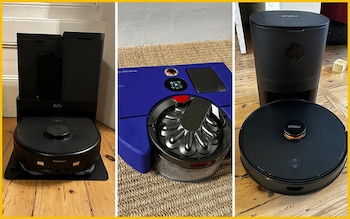
All robot vacuum cleaners have an associated phone app. We tested how easy they were to set up and use and put the robots to work on hard floors, carpets and rugs, leaving each one to run its automated program for one week.
As with all our vacuum tests we put down large dirt like broken crisps, fine dirt like tea leaves and strands of hair to see how they cleaned them up from different surfaces. Where the vacuums had a mopping function, we put down dirty footprints and drops of jam and tea on hard floors.
We were looking for a quiet, competent robot that could find its way around obstacles, didn’t miss a spot and didn’t demand much maintenance.
Best robot vacuum cleaners
1. Dyson 360 Vis Nav
£1,199.99, John Lewis
Best robot vacuum overall, 9/10
We like: very powerful suction, combined with clever navigation system
We don’t like: the high price

- Vacuum size: 10cm height x 33cm length x 32cm width
- Onboard dirt container: 500ml
- Run time between charges: up to 65 minutes
My children howled with delight the first time I switched on the Dyson 360 after a particularly messy breakfast. It’s first run is a mapping run, where it uses its fish-eye camera to work out the surroundings. You can set no-go zones from the app, but I let it roam around our whole ground floor.
The Dyson 360 Vis Nav’s wide fluffy roller comprises bristles and anti-static carbon fibre filaments that, together, are designed to operate on both carpet and hard floors and has very powerful suction. In boost mode, its Hyperdymium motor spins at 110,000 rpm (reportedly six times the suction of other robot vacuums). There’s also a very clever extending side sweeper that can suck up dirt even from the skirting boards.
Thanks to its petite 99mm height, it can zoom right under lots of furniture where a traditional vacuum would struggle to fit: underneath the chest of drawers in my bedroom, for example, had its first clean in a long while. And while there’s a tiny lip between the kitchen and hallway, it can climb up to 21mm without assistance.
But while it’s clever on avoiding big bits of furniture, it mows over stray socks left in its way, for example, meaning that you do have to do a quick tidy up before you start (bad news: robots can’t yet do everything for you). Also, if you want to use the Dyson 360 Vis Nav on a different floor – it only weighs 5kg, so it’s easy to carry upstairs – you do either have to let it set out a new map, or just press the big button on the top of the device and be happy for it to mosey around without a clear plan.
The MyDyson app lets you set no-go zones, cleaning schedules and even the level of clean (such as bathroom – quick; bedroom – boost). The app alerts you when the bin is full and it’s extremely easy to empty – just pop a button to lift a handle, then when you’re over your household bin, flick another switch to empty it.
If you’re connected to Alexa or Google Assistant, you can bark at your assistant to turn the vacuum on for you. But for the less tech savvy, you can just press the “go” button on the top of the machine, too.
I wouldn’t say this is a device intended for a big, deep clean. The small bin capacity and limited run time (a maximum of 65 minutes before trundling back to the docking station to recharge) means it just couldn’t do it, so in my busy family household, I find that I do still need a separate vacuum.
But I really appreciate it for a daily vacuum as I leave on the school run, or even, as I did recently, an emergency upstairs sweep when I heard my in-laws were coming. It’s like a housekeeper on tap, without the awkward chit-chat.
The downsides definitely include the price – there’s no getting away from the fact that this is a seriously expensive way to clean your house. There’s also only a two-year guarantee, which feels a bit stingy for the price; you want to know for sure that this is a piece of kit that’s going to last. Which I hope it does, because the whole family now views our Dyson 360 Vis Nav with pet-like affection.
2. Imou RV-L11-A vacuum cleaner and mop
£421.19, Amazon
Best value robot vacuum, 9/10
We like: impressive tech at this price
We don’t like: not as good in corners and the suction is only middling
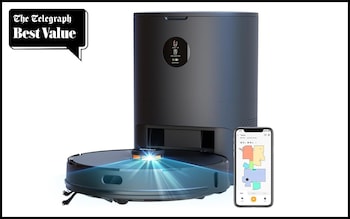
- Vacuum size: 19cm height x 35cm length x 35cm width
- Onboard dirt container: 330ml
- Onboard water tank: 250ml
- Run time between charges: up to 180 minutes
A robot that sweeps, vacuums and mops is the dream, right? The Chinese-made Imou is not bad looking and for a vacuum with integrated moping capabilities, very low profile.
As with all robot vacuums, it first performs its mapping run – basically gathering information on the layout, and any “no-go” areas that you set on the app. The mapping camera spins six times per second, and the internal algorithm works out the most effective and efficient way to clean your house (far better than me, then). Then, after a rest and recharge, it’s ready for its first run, which is the sweeping stage.
Next up is vacuuming or mopping: it can detect when it’s on hard floor or carpets and switches between the two. The vacuum capability has 2,700-pascal suction power (which automatically adjusts depending on how much suction it thinks it needs) a V-shaped brush roller and a 300ml dust bin, which only needs to be emptied, the manufacturers suggest, every 30 days.
When it needs to switch to mopping function, it has a 250ml water tank and a mop cloth holder. The electronically controlled water tank can also be adjusted through the app to control water usage for each individual room’s atmosphere (for example, low water usage in the bedroom, medium in the living room and high in the kitchen). I did feel a bit nervous about the robot trundling over my expensive rugs with water in the tank – any drops could spell disaster for my jute – but it didn’t leave a drop.
The app allows you to programme cleaning schedules and any preferences; but you can also just press a button and let the Imou roam free. When it’s low on power – like many of the devices – it trundles dutifully back to its base station.
The Imou genuinely left my home very clean, but it struggled to get into those hard-to-reach places, or scrub extra hard where you – as a human cleaner – might put in a bit of extra elbow grease. But it’s a very good price for an all-in-one robot vacuum and mop, and for a daily clean it does a great job.
3. Roomba Combo j9+ vacuum and mop
£1,249, iRobot also available at Amazon
Best Roomba, 9/10
We like: clever features in the app that learn more about your home
We don’t like: suction not as strong as the others (especially the Dyson)
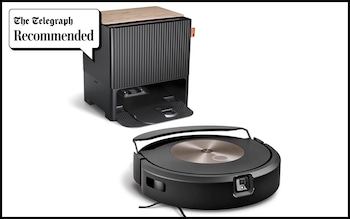
- Vacuum size: 9cm height x 35cm length x 35cm width
- Onboard dirt container capacity: 330ml
- Onboard water container capacity: 313ml
- Run time between charges: up to 180 minutes
Let’s start with its looks: the Roomba Combo j9+ Robot Vacuum and Mop base station looks fantastic, with a ridged wood panel on the front door that looks like a high tech piece of audio equipment. This might sound trivial, but it’s not. Unlike regular vacuums and mops that you store in a cupboard, these devices need to be left out in a central location, near a router.
But the latest Roomba is also a very capable cleaner. Its well-designed iRobot app walks you through an initial mapping run of your house, letting you set up individual rooms and room dividers as well as teaching you how to use the vacuum cleaner – it’s incredibly easy to use, even for the least-technologically able. I did find that that mapping stage took longer than most other devices, but you only need to do it once.
Having set it off on its first clean, I found that it cleverly switched between vacuuming and mopping as it went. It feels counterintuitive to a human cleaner (me), not to do one, then other, but this is certainly more effective. It also has excellent object recognition, navigating around socks and even tiny toys rather than trying to suck them up.
One clever feature is its Dirt Detective, which learns where your dirtiest spots are in a room and targets those first. I also really liked that the mop pads when not in use (while it is vacuuming on a carpet, for instance) not only retract, but sit right on top of the machine, alleviating any worries about dripping dirty water or making contact with particularly thick piled-carpets.
Another great feature is that, unlike the Dyson, it has the capability to empty its dust into the base station, which will hold about two months-worth of dirt before it needs to be emptied. It can also refill its own water reserves from the base station, lasting about one month before you need to refill it. However, the mop head will get very dirty and lose effectiveness if you don’t clean it frequently.
Unfortunately, it’s not totally intuitive to charge: I put the robot in the base station for the first time and didn’t quite make contact with the charging pads. I learned that you need to check the robot’s indicator light. A white light meant fully charged, blue indicated it needed to go back to the base station. For any other “faults” I encountered, such as low battery or low water, it shines red, and either logging into the app tells you what is wrong or touching the button on the machine gives you an audio prompt.
If you don’t want to use the app – although that’s where you can really customise your clean, including no-go zones, set times and intensities of clean – you can set it off with a push of the only button on top of the machine.
Testing the Roomba, I did notice that while it can automatically increase suction where it is needed, it doesn’t have the intense suction of some of the others on the market. All in all, though, this is a great-looking device with remarkable artificial intelligence.
4. Samsung Bespoke Jet Bot Combo AI Steam
£1,299, Samsung
Best robot vacuum and mop, 9/10
We like: Steam sterilisation and hot air drying keep the mop pads hygeinic
We don’t like: Hefty price, confusing set-up
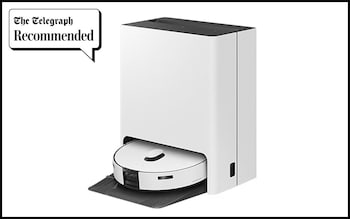
- Vacuum size: 36cm width x 7.5cm height
- Onboard dirt container: 0.25l
- Onboard water tank: 1l
- Run time between charges: 180 minutes
I have to start with a negative: the set up. Some robots are more baffling than others to set up, and despite clear instructions in the app to scan the QR code, my phone did not recognise any of the QR codes (there are, bafflingly, at least eight on the instructions). For someone else it might be seamless, but I spent an hour trying to just get the thing connected.
Once I was up and running, however, I found it impressive. The key selling point to the Samsung Bespoke is its impressive AI capabilities. It means the vacuum identifies – and even, helpfully suggests names for – different rooms and surface areas. It automatically detects different floor types and adjusts its cleaning strategy to suit.
It’s great at object detection – using the two 3D depth cameras, it scans the room and plots out a route, it avoided even tiny bits of Lego that would have normally stumped a human operative (me). The app lets you programme the cleaning mode (mop and vacuum, vacuum then mop, just mop or just vacuum) and which rooms you want cleaning. You can also set up “no go zones”, which can be a section of a room that you don’t want disturbing, for example.
The base station is one of the bulkiest I’ve tested, although relatively inoffensive-looking . It needs to be big: there’s a lot going on. It steam-cleans the mop pads to reduce spread of bacteria and dries them thoroughly with hot air. The base also contains a dustbin and a water reserve. When it needs to empty dust or water, or refill water, it returns to the dock and does it all automatically.
Like many of the new-gen robot cleaners, it has the capability to handle different floor types, lifting its mop pads for carpets (up to 10mm), and even automatically removing the mopping pads at the docking station to switch when it’s in vacuum-only mode for deeper carpets. The mop pads spin around at 170rpm, and when it finds a tricky stain (I’ve got plenty for it to test), it returns to the dock to refresh its mop pads with high-temperature steam before returning to tackle the spot. It really is an impressive clean.
I don’t have pets, but there is a fun function for those who do: the device listens out for sounds from your dogs and cats and alerts you via a message in the app (you can look in on them via the video – and check there’s not a reason they’re upset). From there, you can soothe them with music. Admittedly it’s a niche feature.
The Samsung Bespoke is the most expensive robot vacuum we tried but it did clean exceptionally well, with very little input from me. A more basic Samsung Jet Bot without the self-emptying base station, object-detection or security camera is available for £599.
5. Philips HomeRun 7000 Series Robot vacuum cleaner with mop
Currently £799.99, Amazon
Best robot vacuum for spot cleaning, 9/10
We like: LIDAR floor mapping feature makes it easy to control where you clean
We don’t like: not the quietest robot vacuum
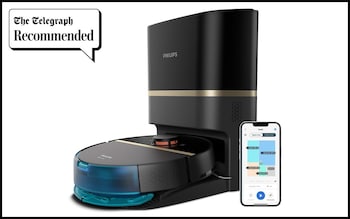
- Vacuum size: H47.1cm x L40.3 x W35.3cm
- Onboard dirt container capacity: 3.0 litres in its auto-empty station (can hold up to 30 days)
- Onboard water container capacity: 240 ml
- Run time between charges: up to three hours
Reviewed by Emily Peck
The Philips has powerful 5000Pa suction and 360 laser navigation (LiDAR) built in, which scans the room to get to know the best path around the floor and avoid obstacles in its way. It’s all controllable via a smartphone app that maps out rooms and allows you to zone clean, clean a whole floor, spot clean an area, highlight no clean zones and mop the floor.
It got right up to the skirting and was slim enough to do a good job under furniture, managing to pick up almost all the dirt in its way. There were some occasions when it got confused and seemed to go off in a random direction, but it was generally quite systematic in its cleaning path.
The suction power on hard floors was impressive and I could see the power boosting on carpet, to get into the fibres and capture finer dust. At 64 decibels the robot can get quite noisy, but there is a quiet mode that takes things down a notch and is useful for night time use.
The beauty of this design is that its mop container can be left on all the time. While at 240ml the water tank is quite small, it was enough to clean my averaged size living room and dining area without leaving the floors soaking wet.
Betty let me know when she was finding her bearings or told me if there was a problem – such as when the brush was tangled or when she needed to return to the base for charging.
While I didn’t find I got the promised three hours of cleaning from one charge, the robot did well to take itself back to the charging dock to empty the dirt containers and power up before venturing out again. The fact that you don’t need to empty the dust bag in the auto-charging dock for 30 days is quite a bonus.
6. Eufy X10 Pro Omni
£799, Eufy
Best robot vacuum for people with allergies, 9/10
We like: strong suction and clever self-cleaning programme
We don’t like: object avoidance is patchy
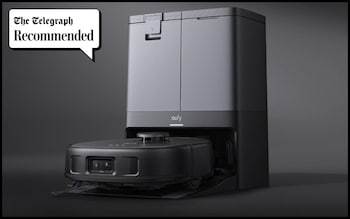
- Vacuum size: 12cm height x 33cm length x 36cm width
- Docking station dirt capacity: 250ml
- Docking station water capacity: 300ml
- Run time between charges: up to 120 minutes
I might declare the Eufy X10 Pro Omni a marriage saver. It’s a device that takes away some of the daily chores and does them very well. It’s relatively discreet, with a smaller docking station than others I’ve tried. The station holds a large 2.5-litre bin bag and two tanks, one for clean water, one for dirty, so you don’t have to clean the mop yourself.
It’s incredibly easy to use. After downloading the (admittedly buggy) app, filling up the tank with clean water and clearing the floors of family detritus, I programmed it to go off on its maiden mapping run. Within about 15 minutes it had mapped out the whole of my downstairs, dividing it into rooms, meaning I could then choose which sections I wanted cleaning.
On vacuum mode, the suction is extremely strong – it boasts 8,000 Pascals (way higher than the Imou), with clever combs that can sweep up pet hair. It also has a special “edge cleaning mode”, which involves the robot working its way in a straight line against the edge of the room. Its shape – more rectangular than most robot vacuums allows it to really get into the corners of a room.
On mop mode (which it flips between as needed), the Eufy X10 Pro Omni uses dual pentagon-shaped mopping pads to really get up all the dirt; these retract 12mm off the ground when going over carpets and rugs. Every 20 minutes (you can change this in app), it goes back to the base station to wash its mop, before setting off again.
When it finishes completely, it cleans and dries its own mops with 40°C air, which helps prevent the build-up of bacteria. Unlike other robot vacuums, you don’t have to empty the waste bin on the machine after each run – it empties itself into its larger bin in the base station and is fitted with a filter to trap microscopic particles – essential for anyone with allergies.
There were a few issues, though: despite its mostly excellent object avoidance technology, it almost knocked over a small occasional table and almost got stuck trying to get over a 2cm-high base of a coffee table (but did eventually manage to get off). It also somehow managed to hoover under my rug on its first attempt, rather than on top of it.
The first run I only had it on “daily clean” setting and didn’t feel that the clean was enough for our lived-in kitchen. But the huge advantage of a robot cleaner over a human one is that you can tell it to do it again, without any arguments. I set it back off, this time turning up to “deep clean”.
It claims to be able to exert 1kg of downward pressure as it mops tough stains, with mop heads that rotate 180 rpm. It did a good job, but still didn’t quite get a ground-in raspberry off the floor completely. To be fair, it had been there longer than 24 hours; Eufy says it can clean stains that have air dried up to 24 hours.
There are more ways to improve the clean from the app: if you go into the mopping function and select deep clean, turbo or max suction and “edge-hugging mopping”, you can get an even more intense clean as it involves the robot making a 52-degree turn every 10cm when it detects a wall. But that does require more battery (on the lowest settings the battery lasts up to 120 minutes) and water, so it’s something to keep an eye on.
The app lets you save different cleaning options, ranging from different room options to intensity of clean to times, to the very specific “post breakfast hoover” as I’ve set one scenario to go as I leave the house on the school run. But you can also – as I found – set it off when you’re on your way home and realise you’ve got guests arriving soon. Genius.
7. Miele Scout RX3
£899, Miele
Easiest robot vacuum to use, 8/10
We like: cute droid-like appearance
We don’t like: it’s relatively noisy
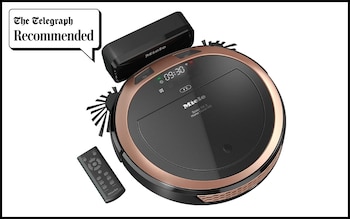
- Vacuum size: 9cm height x 35cm length x 35cm width
- Onboard dirt container capacity: 400ml
- Run time between recharges: up to 120 minutes
German appliance-maker Miele’s RX3 is almost the same price as the Roomba despite being unable empty itself, but are pluses. It has a much smaller, less obtrusive base station its twin cameras look like cute eyes, which can’t be an accident. It’s also much simpler to use, with no real need to download the app: the remote control lets you choose between zigzag auto clean, spot clean or a quick dust and also lets you take manual control, telling it to go forward, back, left or right. Although if you’re standing there doing that, why not just do the hoovering yourself?
If you do use the app, it lets you see your home through the Scout’s eyes, a plausible alternative to a home security camera as long as you don’t mind seeing everything from ankle height. As with the remote, you can take control of the Scout, which is a lot of fun.
Although noisier than the Roomba, it’s better at sweeping debris into its mouth, with long, 20-arm brushes for hard floors and stiffer six-arm brushes for deep carpets, although you have to swap them out yourself. The dust receptacle is about the size of a toothpaste tube and has a built-in brush for cleaning the filter when you empty it. You have to do it about once a week, or once a day if you have pets.
The object-detection is not as good as the Roomba or the Jet Bot below, especially at night, since it relies on camera vision and infrared rather than lasers.
8. Kärcher RCV 5 Robot Vacuum Cleaner
£549.99, Kärcher
Smallest robot vacuum cleaner and mop, 8/10
We like: it’s smart looking with a small docking station
We don’t like: the wifi connection is temperamental
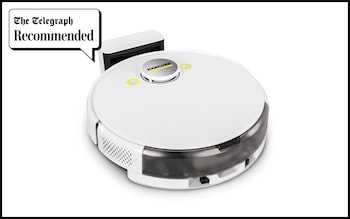
- Vacuum size: 10cm height x 35cm length x 35cm width
- Onboard dirt container capacity: 330ml
- Run time between charges: up to 120 minutes
Reviewed by Rebecca Astill
German manufacturing company Kärcher is perhaps best known for its pressure washers and floor care and has recently expanded into robot vacuums. The RCV 5 not only vacuums but also mops, using water and a semicircular cloth at the back of the machine. Obstacle avoidance and AI mapping are good and, unlike other robot vacs, it’s able to lift itself over steps up to 2cm high. There are some teething issues and it’s quite expensive, but an impressive debut.
Out of the box, the robot vacuum is compact if a little plasticky looking. Unlike bigger robot vacuum-mops, it holds the rubbish inside itself, allowing for a much smaller docking station. Considering one of the key target audiences for robot vacs are flat dwellers who often lack space, a small docking station is a pretty big tick.
The robot will happily run by itself, although you will see it going in circles for a few minutes at the start of runs. It usually fixes itself after a few circles. The dust box only needs emptying every few cleans. The mop will need cleaning after every run.
Connect it to the app and the RCV 5 will create a map of the rooms in your home. You can set areas to avoid, which rooms want mopping as well as vacuuming and any to avoid altogether. The app itself is great once set up, but I had considerable difficulty connecting it to the vacuum.
Performance-wise, the vacuum performs as well as I’d want it to. It effectively clears debris and mops everything but tougher stains. I just wish it more easily connected to the app.
9. Xiaomi Roborock S7 Max Ultra
£799, Amazon
Best robot mop, 7/10
We like: ‘sonic’ mopping and better AI makes it more effective in the wet than the other robot mops
We don’t like: the app is glitchy
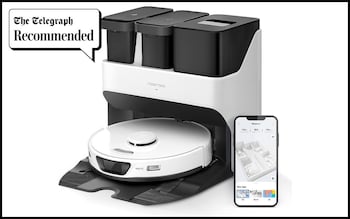
- Vacuum size: 10cm height x 35cm length x 35cm width
- Onboard dirt container capacity: 470ml
- Run time between recharges: up to180 minutes
As you will have gathered, hybrid vacuum-mop robots like the Roomba Combo are becoming the standard. The Chinese-made Roborock’s unique selling point is that the mopping isn’t an add-on but the dominant element.
Some British customers might feel a bit wary about giving a Chinese robot their wifi password and letting it trundle around their house taking pictures (it can also listen), but that is how the Roborock works. Using a combination of camera, LiDAR and structured-light 3D mapping, it not only maps your house but recognises furniture and places it on the map, so you can direct it to clean under the dining room table, for example.
In our tests the obstacle detection was impressive, about as good as the Samsung, but in vacuum mode the solid-rubber brush wasn’t so good at lifting fine dust and got tangled with hair. It would also randomly stop and give confusing error messages. Really, though, this is all about the mopping.
No robot mop can match a human, but the Roborock S7 does better than most, vibrating the mop head 50 times a second in what it calls ‘sonic mopping’. It’s just water (cleaning products would clog the system), but it was enough to remove muddy footprints and tea and coffee stains from around the bin and to give the kitchen an overall freshen-up.
We tested the ‘MaxV’ version, whose base station includes a tank for topping the robot up, a dustbin so it can automatically empty itself and a washing system to clean the mop. This is undeniably convenient, but it’s the size of the average waste bin and takes up a lot of of space in the kitchen.
Overall, the Roborock is an impressive bit of 21st-century technology with quite a few bugs which software updates will need to iron out.
10. Ultenic D5s Pro Robot Vacuum Cleaner with Mop
£116.61, Amazon
Best robot vacuum cleaner under £100, 7/10
We like: suction is impressive and works well on carpet and hard floor
We don’t like: no LiDAR technology for detailed scans and map out rooms
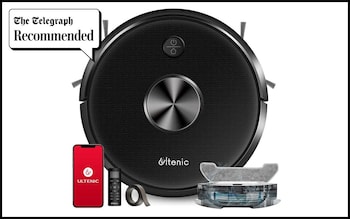
- Vacuum size: H7.3 x W32.4 x L32.5cm
- Onboard dirt container capacity: 500ml
- Onboard water container capacity: 0.3 litres
- Run time between charges: up to 150 minutes
Reviewed by Emily Peck
The Ultenic provided decent suction on dusty carpets and was pretty impressive when sweeping and mopping hard floors. At 3000Pa, its suction is not quite as powerful as the 5000Pa Philips design, but I did find it effective for everyday mess including biscuit crumbs, pet hair and mud. It even picked up sand and I tried it on oats too – though it spat a few around the room before clearing them later on when it eventually discovered them.
When it went across carpet I heard the suction power increase. The robot can also climb objects of 16mm in height, which worked well when driving across pieces of Lego left on the floor. To use the mop mode, you need to switch out the dirt container for the water tank. It has an app that shows you in real time where it’s working to clean.
The robot comes with a charging dock that unlike bulky auto-charging docks with self-emptying bins, is ideal for smaller rooms. At 500ml the dustbin is quite small, so keeping on top of emptying it to keep the vacuum running at optimum performance is a must. To cordon off no-clean zones, you’ll have to use the boundary strips that come in the box and this can be a bit of an eyesore and faff.
While spot cleaning isn’t quite as precise as it is when using the advanced robot vacuum apps, this design does allow you to place the robot in an area and choose spot cleaning mode that intensely cleans a localized area about 3 feet in diameter.
The kit comes with spare filters and brushes, a remote control and smart app – with an option to link it to an Alexa smart speaker so you can use voice control too. I think that if you’re keen to try a robot vacuum and haven’t got the budget to spend on a premium design, this makes for a good introduction into the world of robot vacuuming.
Robot vacuum cleaner FAQs
What robot vacuum has the strongest suction?
The brand new Dyson 360 Vis Nav, reviewed above, has six times the suction power of any other robot vacuum. Generally, powerful suction is not what robot vacuum cleaners are all about. They’re not the best vacuums for pet hair, either: they lack the turbo brushes and anti-tangle technology. Our recommendations above are based on usability and technical sophistication, not brute power.
How long does a robot vacuum last?
About five years, although there are still original Roombas in use from 15 years ago, according to robotics expert Colin. As with mobile phones, after a while your robot vac will simply start to feel like yesterday’s model.
You may be getting the impression that we’re not fully sold on robot vacuums. We actually had a lot of fun testing them: they’re charming to have trundling around and kids love them, as do the abovementioned Roomba-riding cats. But the plain fact is that they’re better suited to big American houses than the average British flat or semi.
In theory they would be good for people with mobility problems who find it hard to operate a traditional vacuum cleaner. But setting up the obligatory apps will be a barrier to many. So in our opinion, they’re more of a technical marvel than a cleaning solution.
View the latest Samsung and Amazon deals
Disclaimer: The copyright of this article belongs to the original author. Reposting this article is solely for the purpose of information dissemination and does not constitute any investment advice. If there is any infringement, please contact us immediately. We will make corrections or deletions as necessary. Thank you.



